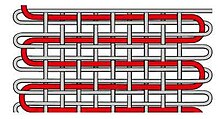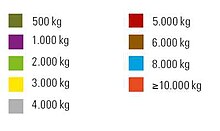Round sling
A round sling (also slip called) is a sling that can carry up to 400 tons. It is made from high-strength, light- and heat-stabilized PES multifilament that is wound endlessly. The finished round sling is therefore very flexible, so that it adapts effortlessly to the contours of any load.
material
Textile slings must be made from high-strength multifilament yarns, from polyester (PES), polyamide (PA) or polypropylene (PP). Round slings may only consist of a single material. When choosing the right lifting gear, all environmental influences must be taken into account: Extreme temperatures or aggressive substances - such as acids or alkalis - can reduce the durability of the textile straps or make them impossible to use.
Protection against wear
Round slings are exposed to great stress through daily use. Therefore, some protective measures have been developed such as B. a protective hose with special ribs made of high-performance polyester, which significantly reduce wear. A textile wire is woven into many round slings to protect against cracks. Both together result in a longer service life.
The right lifting gear
Which form of textile lifting gear is the right one depends on the application, e.g. B. whether the load is compact or voluminous, has fixed attachment points, the surfaces are sensitive or whether the load has sharp edges. Round slings can be used to lift loads that do not have fixed attachment points. They have a load capacity of up to 400 tons. Extra abrasion-resistant surface and woven textile wire reinforcement make many loops particularly robust. Coated protective hoses are used to protect against heavy wear.
Load capacity
To make it easier to choose the right round sling, some manufacturers use color codes and labels . The color coding of the straps according to EN 1492-2 shows whether the load-bearing capacity in a straight pull is sufficient for the respective loads. This nominal load capacity (WLL) changes with the different types of attachment. This means that larger loads can also be lifted under certain circumstances. In addition to the nominal load capacity, the load capacity in the most common applications can also be read on the label.
Standards and regulations
In Germany there are some regulations for lifting loads that must be observed in addition to European law. In principle, the following provisions apply to textile slings:
In Europe:
- Machinery Directive 2006/42 / EC
- EN 1492-1
- EN 1492-2
Colors: 500 olive / 1000 violet / 2000 green / 3000 yellow / 4000 gray / 5000 red / 6000 brown / 8000 blue /> = 10,000 kg orange
Additionally in Germany
- Industrial Safety Ordinance
- BGR 500 chap. 2.8
- ZH 1/324
- Factory standards
See also
Individual evidence
Web links
- Use of flat slings and round slings made of man-made fibers (accessed on July 16, 2020)
- Textile lifting gear (accessed on July 16, 2020)
- Round slings and flat slings (accessed on July 16, 2020)
- Original operating instructions for round slings and flat slings (accessed on July 16, 2020)
- Round sling According to DIN-EN 1492-2 (accessed on July 16, 2020)


